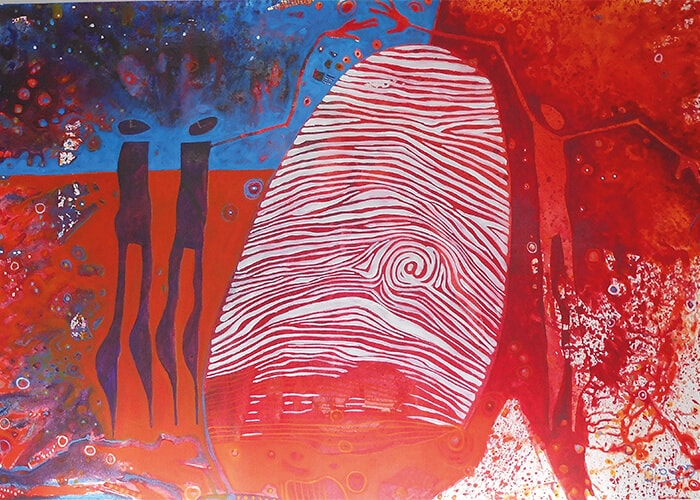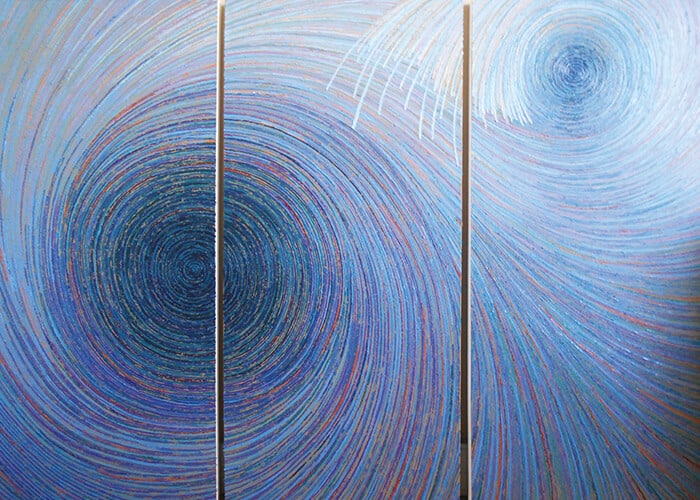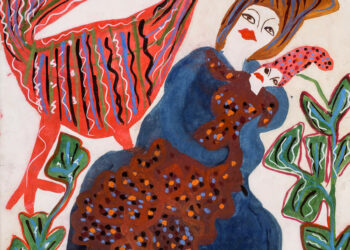Galerie NOKO features works by various artists offereing diffused social, cultural or traditional views on contemporary culture. ART AFRICA caught up with artist and Galerie NOKO director Usen Obot and the dynamic Johan Bloom, to discuss their various practices and the work that will be on show at the FNB JoburgArtFair 2016.
 Johan Bloom, detail of Humanity @ Border, 2016. Acrylic on canvas, 170 x 115 cm. Images courtesy of Gallery NOKO.
Johan Bloom, detail of Humanity @ Border, 2016. Acrylic on canvas, 170 x 115 cm. Images courtesy of Gallery NOKO.
ART AFRICA: You’re a self-taught artist, in the sense that you never attended any formal or institutionalised arts programme. To what extent do you believe this has allowed you to find an artistic vocabulary of your own, and how has your voice evolved since you began making art?
Johan Bloom: Art is a way of investigating life and trying to understand the society we live in. My pictorial language has evolved from two regions; Scandinavia and Southern Africa. My first forays focused on naturalistic bird paintings in watercolour. As a young artist my goal was to become a birds’ book illustrator. Throughout my journey, I tend to adapt to my environment. In Botswana I embraced the nature of the Kalahari. Moving to Maputo (Mozambique) was a game changer as I began to study the local masters, including Malangantana Ngwenya and Naguib Abdula, the latter subsequently became my tutor. This gave me something new and different. It did not fit into the art education in Sweden in the 80s, where I took a foundation course, but never ventured into higher art studies. I ended up going back to Southern Africa as a self-teaching artist.
Formal education is a shortcut and gives you a good platform to start from. But it also gives you the constraint of the educational worldview, ideas and culture. I love the freedom in art. It can be anything; provocative, boisterous or decorative. Good art touches something deeper within us.
You’ve lived between Southern Africa and Sweden all your life, going back and forth. How has this experience influenced your art-making?
Southern Africa in general, and Mozambique in particular has over the years been my main source of inspiration. A lot has changed in the world since I first met the art in Maputo. Globalisation and the internet have brought us closer, but also highlight the gaps. European, western art only marginally interests me, but nevertheless I am a bearer of that culture. Art has been my way of bridging the gaps; mending and merging two very different regions into something new, yet recognisable.
I have always come to Southern Africa to learn about art, never to teach. In South Africa I think the Eurocentric art canon has been and still is a major obstacle. I believe that artists from all over the world will come to places like Nigeria, Maputo, Nairobi and Johannesburg in the future. Africa is where the centre of art will be, not in Paris, London, New York and Berlin…
Your work is described as “an artistic wandering to bring dynamic balance between north and south, history and contemporary life, rock-carvings and the digital world.” How does your creative process reflect these dual narratives?
Born in the North with a heart in the Southern Hemisphere I have searched for similarities rather than differences between the two. Looking at the Drakensberg rockpaintings and the rock engravings in Sweden, the similarities are striking, as if made by the same artist! Venturing further into earlier cultural expressions one will find that we had more in common before modern man created ideas of race, supremacy and oppression.
In my pictures I use human figures from the north and south, as well as modern symbols, like the ‘@’ sign, barcodes and biometric fingerprints. I try to bridge our human history where past and present walk side by side. Often with striking colours and a contradictory title like Colour-free Identity.
As a point of departure all my paintings take us humans as being one and the only barriers and boundaries are the ones we create ourselves. I have always looked for, enjoyed and tried to capture that new mix of what I have around me. I have started to call this The Third Culture.
Please tell us about the body of work on show at the FNB JoburgArtFair?
The body of work presented at the JoburgArtFair are the embryos of my upcoming solo exhibition at Galerie NOKO, with the working title ‘Third Culture.’ The artworks all involve identity, or rather multiple identities in a global world. We all enrich each other with different cultures and histories which can merge into something new: The Third Culture. It is a culture where human creativity flourishes and diversity is embraced, celebrated, and developed.
 Usen Obot, detail of Eqiulibrium of Love and Hate, 2016. Oil on canvas, triptych, 210 x 150 cm.
Usen Obot, detail of Eqiulibrium of Love and Hate, 2016. Oil on canvas, triptych, 210 x 150 cm.
ART AFRICA: You were born in Port Harcourt, Nigeria and have lived in Port Elizabeth since 2003, where you have played an integral role in the development of artistic practice. How has this experience influenced your art?
Usen Obot: You are torn between two worlds, between self-definition and an active engagement in the cultural and artistic practice of others. These inextricable roles add to my nuances and iterations as it has led to and created pathways into backgrounds with intrinsic dialogue. My straddling both worlds has inevitably fuelled my practice as it has also driven my focus toward questioning and engaging with the intricate nature of integration, mutual coexistence and the comprehension of diverse communities.
You’ve worked in multiple mediums, from ink, water colour, and oils to clay, leather, perspex and metal. What informs your choice of subject matter?
My subject matter is humanity, relationships – existing and non-existing, unanswered and answerable questions, mind-sets and the human capacity of thought. As an artist I am currently driven in my iterations to use mediums available to me and engage with the socio-political and multicultural narratives in our community. My works are chiefly abstract allegorical expressions.
According to your artist statement, your work, as well as your process has evolved to “reflect and encompass our society’s present state, [your] experiences and the thinking that [you] wish to provoke.” Please could you elaborate on this?
An individual, a community or an entire society are driven by circumstances, thought processes, acts of omission or commissionThis will invariably lead to a point where they have to engage with themselves, the community or the issues and face the realities, whether they are right or not. My work seeks to provide the conduit for us to reassess, question, and evaluate these spaces.
Please tell us about some of the themes inherent in your work, on show at the FNB JoburgArtFair?
My body of work for the FNB JoburgArtFair are from the series titled ‘The State Of Mind.’ These two dimensional works (impasto, oil on canvas) are abstracted interpretations that emphasize the power and evolution of thought. In the Equilibrium Of Love and Hate, Mechanism Of Hope, and Light Overcoming Darkness, my metaphorical expressions are inspired by the waves of the sea and other forces of nature that are in some form inherent in each of us.
This interview was first published in the September 2016 edition of ART AFRICA magazine, entitled ‘BEYOND FAIR’.



